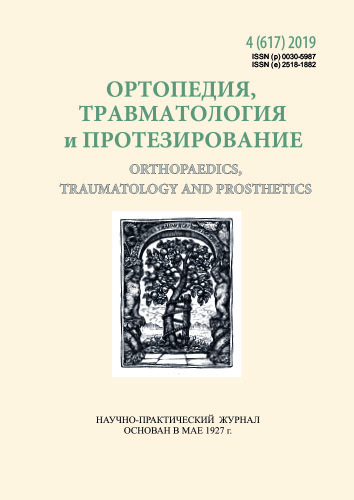Mathematical modelling of a new implant for interbody lumbar spinal fusion
DOI:
https://doi.org/10.15674/0030-59872019442-49Keywords:
finite element models, interbody spinal fusion, implant, vertebrae body, stress-strain state contact pressureAbstract
Objective: using mathematical modeling with the finite element method to develop a model of the interbody implant with an additional fastening element and to evaluate the stress-strain state of the system «vertebral body – implant». Methods: models were designed in SolidWorks software. Two designed schemes with implants were developed and studied: 1) titanium cylindrical; 2) titanium cylindrical with an additional fastening element — a spike. The condition of the Ist stage of the study is the absence of movements of the elements of the contact pair «implant – vertebral body», the IInd — a small relative slip between them with zero friction. Bending loads on the segment were created. Results: the application of an additional fastener significantly increases the rigidity of the entire system. Redistribution of stresses occurs with their decrease in the implant with an additional fastening element by 30 % than without it. The equivalent stresses of cortical tissues for the first and second calculation schemes of the first stage of the study turned out to be close in values, the difference is 2 %. For stage II, the difference was 43 %, higher stresses were observed in the case of implant with a spike. Contact pressure indices in models with two types of implants in the absence of movements in the «implant – vertebral body» system are close, the difference is 5 %. In the case of modeling of a small relative slip between them with zero friction (stage II), the difference in values rises up to 54 %, and the lower pressure corresponds to the implant model with a spike. Conclusions: the use of an improved design of the interbody implant with an additional fastening element in the form of a spike is more effective to achieve stabilization in the system of the «vertebral body – implant» compared with a conventional cylindrical implant.
References
- Radchenko, V. A., & Korzh, N. A. 2004. Workshop on stabilization of the thoracic and lumbar spine. Kharkov: Prapor. (in Russian).
- Radchenko, V., & Popsuishapka, K. (2009). Modern approaches to the surgical treatment of spinal injuries. Orthopaedics, Traumatology and Prosthetics, 3, 89–92. doi: https://doi.org/10.15674/0030-59872009389-92. (in Russian).
- Filippiadis, D. K., Marcia, S., Ryan, A., Beall, D. P., Masala, S., Deschamps, F., & Kelekis, A. (2018). New implant-based technologies in the spine. CardioVascular and Interventional Radiology, 41 (10), 1463–1473. doi: 10.1007/s00270-018-1987-z.
- Papanastassiou, I. D., Gerochristou, M., Aghayev, K., & Vrionis, F. D. (2013). Defining the indications, types and biomaterials of corpectomy cages in the thoracolumbar spine. Expert Review of Medical Devices, 10 (2), 269–279. doi: 10.1586/erd.12.79
- Weber, M. H., Fortin, M., Shen, J., Tay, B., Hu, S. S., Berven, S., & Deviren, V. (2017). Graft Subsidence and Revision Rates Following Anterior Cervical Corpectomy. Clinical Spine Surgery, 30 (9), E1239–E1245. doi: 10.1097/bsd.0000000000000428
- Lau, D., Song, Y., Guan, Z., La Marca, F., & Park, P. (2013). Radiological outcomes of static vs expandable titanium cages after corpectomy. Neurosurgery, 72 (4), 529–539. doi: 10.1227/neu.0b013e318282a558
- Zienkiewicz, O. C., Taylor, R. L., & Zhu, J. (2013). The Finite Element Method: Its Basis and Fundamentals. Amsterdam, Heidelberg: Butterworth-Heinemann.
- Korzh, M., Kutsenko, V., Tymchenko, I., Popov, A., Harashchenko, Y. A., & Byelyy, Y. E. (2019). Mathematical and computer simulation of the behavior of segments of the lumbar spine after prosthesis. Trauma, 20, 5, 6–14. doi: 10.22141/1608-1706.5.20.2019.185549 [in Ukrainian]
- Alyamovsky, A. A. (2004). Design of SolidWorks/CosmosWorks. Finite Element Engineering Analysis. Moscow: DMK. (in Russian)
- Zienkiewicz, O. C., Taylor, R. L., & Mc Graw-Hill (1989). The Finite Element Method: Basic formulation and linear problems. London.
- ANSYS Workbench. Retrieved from http://www.ansys.com
- Obraztsov, I. F., Saveliev, L. M., & Khazanov, H. S. (1985). The finite element method in the problems of structural mechanics of aircraft: A manual for students of aviation. specialist. Universities. Moscow: Higher School. [in Russian]
- Morozov, E. M., & Nikishkov, G. P. (1980). The finite element method in fracture mechanics. Moscow: Nauka. [in Russian]
- Boyko, I. V., Sabsai, A. V., Makarov, V. B., & Rajabov, O. V. (2012). Mathematical modeling of the stress-strain state of the bone-implant system during intertrochanteric fracture of the femur. Bulletin of SevNTU: collection of scientific papers, 133, 355–360 (Seriya: Mechanics, energy, ecology). (in Russian)
- http://metallicheckiy-portal.ru/marki_metallov/tit.
Downloads
How to Cite
Issue
Section
License
Copyright (c) 2020 Mykola Korzh, Volodymyr Kutsenko, Andrey Popov, Oleg Veretelnik, Iryna Timchenko, Mykola Gnyrya, Mykola Tkachuk, Mykola Tkachuk

This work is licensed under a Creative Commons Attribution 4.0 International License.
The authors retain the right of authorship of their manuscript and pass the journal the right of the first publication of this article, which automatically become available from the date of publication under the terms of Creative Commons Attribution License, which allows others to freely distribute the published manuscript with mandatory linking to authors of the original research and the first publication of this one in this journal.
Authors have the right to enter into a separate supplemental agreement on the additional non-exclusive distribution of manuscript in the form in which it was published by the journal (i.e. to put work in electronic storage of an institution or publish as a part of the book) while maintaining the reference to the first publication of the manuscript in this journal.
The editorial policy of the journal allows authors and encourages manuscript accommodation online (i.e. in storage of an institution or on the personal websites) as before submission of the manuscript to the editorial office, and during its editorial processing because it contributes to productive scientific discussion and positively affects the efficiency and dynamics of the published manuscript citation (see The Effect of Open Access).














